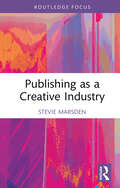- Table View
- List View
Public-Private Dialogs to Spur Export-led Growth: The Case of Productivity Taskforces in Namibia (Elements in the Economics of Emerging Markets)
by Miguel Angel Santos Andres FortunatoThis case study examines the implementation of Namibia's first Productivity Task Force focused on the high-value fruit sector from 2021 to 2024. Productivity task forces, modeled after Peru's Mesas Ejecutivas, facilitate public-private dialogues to resolve sector-specific productivity issues. The Namibian Investment Promotion and Development Board, the Ministry of Agriculture, Water and Land Reform, and the Ministry of Finance led the Namibian task force. The study highlights critical stages, including the task force's management and organization, political authorization, and the identification and resolution of productivity problems. While some challenges remain unsolved, the PTF has laid the groundwork for long-term improvements in government capacity, better public-public coordination, public-private collaboration, and a more business-friendly environment. The study offers valuable insights for implementing similar public-private initiatives in other developing countries. This title is also available as Open Access on Cambridge Core.
Public-Private Partnership Projects in Infrastructure
by Jeffrey DelmonInvestment in infrastructure is critical to economic growth, quality of life, poverty reduction, access to education, healthcare, and achieving many of the goals of a robust economy. But infrastructure is difficult for the public sector to get right. Public-private partnerships (PPPs) can help; they provide more efficient procurement, focus on consumer satisfaction and life cycle maintenance, and provide new sources of investment, in particular through limited recourse debt. But PPPs present challenges of their own. This book provides a practical guide to PPPs for policy makers and strategists, showing how governments can enable and encourage PPPs, providing a step-by-step analysis of the development of PPP projects, and explaining how PPP financing works, what PPP contractual structures look like, and how PPP risk allocation works in practice. It includes specific discussion of each infrastructure sector, with a focus on the strategic and policy issues essential for successful development of infrastructure through PPPs.
Public-Private Partnerships for Major League Sports Facilities (Routledge Research in Sport Business and Management)
by Judith Grant LongThis volume takes readers inside the high-stakes game of public-private partnerships for major league sports facilities, explaining why some cities made better deals than others, assessing the best practices and common pitfalls in deal structuring and facility leases, as well as highlighting important differences across markets, leagues, facility types, public actors, subsidy delivery mechanisms, and urban development aspirations. It concludes with speculations about the next round of facility replacement amidst rapid changes in broadcast technology, shrinking domestic audiences, and the globalization of sport.
Public-Private Partnerships in Deutschland (essentials)
by Sarah WolffPublic-Private Partnerships (PPP) haben sich in Deutschland und international als wünschenswerte Beschaffungsalternative für die Öffentliche Hand etabliert. Was den privaten Partner antreibt oder antreiben könnte, sich auf eine solche Partnerschaft einzulassen, wird meist nicht thematisiert. Und sind nahezu ,,insolvente" öffentliche Institutionen wirklich attraktive Partner für die Privatwirtschaft? Bedeutet eine PPP-Realisierung nicht auch das Aufschieben staatlicher Zahlungen in die Zukunft? Inwiefern können private Akteure Monopolgewinne abschöpfen, wenn sie ein staatlich geschütztes Monopol bewirtschaften? Sarah Wolff gibt Antworten auf diese und andere Fragen.
Public-Private Partnerships in Infrastructure
by Kumar V. Pratap Rajesh ChakrabartiThe book provides readers with a clear understanding of infrastructure challenges, how Public-Private Partnerships (PPP) can help, and their use in practice. Infrastructure bottlenecks are generally considered the most important constraint to growth in many countries worldwide. Historically, infrastructure projects have been financed and implemented by the state. However, owing to the fiscal resource crunch, time and cost over-runs, and the general poor quality of publicly provided infrastructure, many emerging market governments, including India, have increasingly adopted PPPs with billions of dollars of investment riding on them. The results have been varied - from spectacular airports like the Delhi International Airport Limited with the associated controversy over land use, to the renegotiation of contracts as in the case of Tata Mundra Ultra Mega Power Project. Illustrating concepts with relevant case studies, the book makes the challenges of PPPs understandable to industry and management practitioners as well as students of management, public policy and economics. It is useful to practitioners wishing to avoid the pitfalls in the tricky terrain of PPPs and policymakers wanting guidance in crafting proper incentives. It also helps students gain a holistic and "applied" understanding of this increasingly important and popular model.
Public-Private Partnerships in Russia: Institutional Frameworks and Best Practices (Competitive Government: Public Private Partnerships)
by Agnessa O. Inshakova Oleg V. IvanovThis volume presents the history and current state of the public-private partnership (PPP) sector in Russia. It analyzes the legal and institutional framework of PPPs as well as approaches and best practices for public administrations at federal and regional level to promote PPPs. Special attention is given to the management of PPP projects in different phases of their life cycle and to the legal and financial structuring of PPP projects. In addition, the contributions highlight best PPP practices in various sectors - from transport infrastructure to information technology - and also discuss international aspects of PPP. The volume is aimed at scholars in economics and public administration as well as public decision-makers interested in modern trends in the Russian economy and the development of successful business development.
Public-Private Partnerships in the European Union (Routledge Critical Studies in Public Management #16)
by Christopher BovisPublic procurement in the European Union represents almost twelve per cent of the EU's GDP and is continuing to increase, having been identified as a key objective in the EU's aim to become the most competitive economy in the world by 2010. This book provides a one-stop shop, multi-disciplinary approach to public procurement and will be of use to academics and policy-makers. Providing its readers with practical description and analysis of the relevant policies, law and jurisprudence, the book also explores possible future trends in public procurement regulation.
Public-Private Partnerships in the USA: Lessons to be Learned for the United Kingdom (Routledge Critical Studies in Public Management)
by Tony WallBroadly, a Public-Private Partnership (or PPP) is any collaboration between the public and private sector, but research in the UK has tended to focus on those that have been used for major infrastructure projects, such as roads, schools, and hospitals. This book compares and contrasts PPP research in the UK with that of cases in the USA, including interviews with some of the key stakeholders (decision makers in the public sector, contractors, and users) of PPPs in North America, and observations of PPPs in action (such as schools and roads). No prior major studies have compared the UK and USA when it comes to the development and operation of PPPs, and this book fills a gap in the literature, addressing a number of key questions, including: Is the private sector viewed with less suspicion in the USA when it comes to projects that would normally fall under the aegis of the public sector? How do politics affect PPPs? How do key players in the PPP process define project success, determine the merits and drawbacks of the initiative, and deal with controversial elements of the scheme such as value for money and risk transfer? The result is a volume that offers practical advice for the future development of PPPs in the UK.
Public-Private Partnerships: Theory and Practice in International Perspective
by Stephen OsbornePublic-Private partnerships are an increasing aspect of the delivery of public policies and services across the world. This book is the first to draw upon a range of disciplines to offer theoretical perspectives upon their analysis as well as a range of case-studies of their management from around the world. It also offers a number of frameworks fo
Public-Private Stewardship: Achieving Value-for-Money in Public-Private Partnerships
by Joshua M. SteinfeldThis book offers a defense acquisition perspective that provides action orientations and decision making to increase the value-for-money (VFM) of public-private partnerships (PPPs) through public-private stewardship (PPS). The differing motives of the public and the private sector are not conducive to partnership that leads to optimal outcomes. PPS is offered to practitioners and academics as a solution to failures of PPPs by following the public stewardship tenets of fiduciary responsibility and advancing the public interest while factoring in the additional elements of the private sector. The public values of transparency, accountability, responsibility, responsiveness, efficiency, effectiveness, equity, diversity, inclusion, fairness, and security, among others, can be shared in success between the public and private partners. By establishing shared values aligning with each stakeholder’s measures for success, it is possible to devise value propositions for stakeholder decision making that supports inter-organizational strategy, operations, tactics, goals, and objectives. PPS practices can further ensue as the public-private steward utilizes tools of expertise and organizational capacity. The book provides seven portraits of practitioners in the practice of PPS to assist PPP stakeholders achieve VFM. PPS is illustrated using examples in the Department of Navy (DON) and Department of Defense (DOD).
Public-Sector Organizations
by Robert S. Kaplan David P. NortonThis chapter presents strategy maps for several public-sector organizations, including the Royal Canadian Mounted Police, the United Kingdom Ministry of Defense, and the Fulton County School Systems. These case studies provide examples of how to build a comprehensive, integrated visual representation of strategy, the first step to becoming a strategy-focused organization.
Publications of the German Historical Institute: Austrian Banks in the Period of National Socialism
by Gerald D. FeldmanThis book is the English translation of Gerald D. Feldman's contributions to the multi-author, two-volume study sterreichische Banken und Sparkassen im Nationalsozialismus und in der Nachkeriegszeit, which was originally published in German by C. H. Beck in 2006. Austrian Banks in the Period of National Socialism focuses on the activities of two major financial institutions, the Creditanstalt-Wiener Bankverein and the Lnderbank Wien. It details the ways the two banks served the Nazi regime and how they used the opportunities presented by Nazi rule to expand their business activities. Particular attention is given to the role that the Creditanstalt and Lnderbank played in the 'Aryanization' of Jewish-owned businesses. The book also examines the two banks' relations with their industrial clients and considers the question of whether bank officials had any knowledge of their client firms' use of concentration camp prisoners and other forced laborers during World War II.
Publications of the German Historical Institute: Bavarian Tourism and the Modern World, 1800–1950
by Adam T. RosenbaumDuring the nineteenth and early twentieth centuries, the tourism industry of Bavaria consistently promoted an image of 'grounded modernity'. This romanticized version of the present reconciled continuity with change, tradition with progress, and nature with science. In an era of rapid and unprecedented change, simultaneously nostalgic and progressive grounded modernity produced an illusion of continuity. It helped make the experience of modernity more tangible by linking impersonal and abstract ideas, like national identity, with familiar experiences and concrete sights. Bavarian Tourism and the Modern World, 1800-1950 examines the connections between Bavarian tourism and the turbulent experience of German modernity during this period. It gauges Germany's long and often unsettling journey to modernity using Bavarian tourism and travel as a lens. Closely examining guidebooks, brochures, postcards and other tourist propaganda, Adam Rosenbaum argues that by pointing visitors to the past, tourism illuminated the present, and produced signposts to the future.
Publicis Groupe 2009: Toward a Digital Transformation
by Rosabeth Moss Kanter Matthew BirdAfter a series of acquisitions, Maurice Levy, the Chairman and CEO of Publicis Groupe, had created the fourth largest marketing and communications company in the world. His next major challenge was managing the firm's digital transformation. In December 2006, the company acquired Boston-based Digitas, a leading digital agency headed by David Kenny. After the initial merger, which included the unbundling of Digitas capabilities and the global expansion of its agency network, Publicis Groupe launched VivaKi, a new company-wide digital platform, to spearhead the firm's total transformation. But since the June 2008 launch, the global economy had taken a turn for the worse. Could Levy, Kenny, and other leaders change the holding company quickly and effectively enough to make the new model work?
Publicis Groupe 2021: Changing Nearly Everything
by Rosabeth Moss Kanter Vincent Dessain Tonia LabruyereAfter taking over from long-standing CEO Maurice L vy, Arthur Sadoun became the new CEO of the French advertising group in 2017. With L vy still serving as Chairman and supporting him in the leadership transition, Sadoun has to find ways to keep Publicis on track in a fast-changing industry, where increased digitalization created new competitors and new ways of working. While simultaneously dealing with the challenges of a global pandemic, Sadoun tries to find ways to make Publicis fit for the future and anticipate where the industry as headed.
Publicly Funded Agricultural Research and the Changing Structure of U.S. Agriculture
by Committee to Review the Role of Publicly Funded Agricultural Research on the Structure of U.S. AgricultureA report on Publicly Funded Agricultural Research and the Changing Structure of U.S. Agriculture
Publicly Traded Family Businesses: A Long-Term Study on Family Involvement and Company Longevity (Familienunternehmen und KMU)
by Kirsten StotmeisterGoing Public - a decision of great scope, from opportunity to demise. Many firms find themselves at a crossroads, sooner or later. Especially for family-owned businesses the decision to go public may bear additional risks. In the end, the question arises - how did it work out for others? This is where this book latches on. The focus of the study lays on German stock-listed family firm longevity and family involvement. With an observation period comprising 68 years, German family businesses with an IPO launch between 1950 and 1988 have been screened for changes regarding family shareholding and involvement along the timeline until the end of observation in 2018. The study reveals outcomes of numerous family businesses after IPO, of positive as well as negative nature. In the end, the findings have been combined into a model reflecting the identified success factors of the surviving stock-listed family businesses.
Public–Private Partnership Projects in Infrastructure: An Essential Guide for Policy Makers
by Delmon JeffreyInvestment in infrastructure is critical to economic growth, quality of life, poverty reduction, access to education, healthcare, and achieving many of the goals of a robust economy. But infrastructure is difficult for the public sector to get right. Public-private partnerships (PPPs) can help; they provide more efficient procurement, focus on consumer satisfaction and life cycle maintenance, and provide new sources of investment, in particular through limited recourse debt. But PPPs present challenges of their own. This book provides a practical guide to PPPs for policy makers and strategists, showing how governments can enable and encourage PPPs, providing a step-by-step analysis of the development of PPP projects, and explaining how PPP financing works, what PPP contractual structures look like, and how PPP risk allocation works in practice. It includes specific discussion of each infrastructure sector, with a focus on the strategic and policy issues essential for successful development of infrastructure through PPPs.
Public–Private Partnership for Sub-Saharan Africa (Advances in African Economic, Social and Political Development)
by Hanna KociemskaThis monograph highlights the benefits of public-private partnerships (PPP) for Sub-Saharan Africa. By studying the intertwinement of mainstream and Islamic finance, the author shows how PPPs have emerged as a viable and efficient organizational vehicle for fair rules of economic cooperation where the trade-offs between profit maximization and social justice values required by Islamic finance occur within the organization. The book shows the assumptions under which such compromise is beneficial to all parties, including public entities, multicultural societies and private Islamic and conventional investors. It places particular emphasis on changing the principle of allocating public resources in the uncertain legal and economic environment of the region discussed. Given the cultural idiosyncrasies, political instability, and socio-economic turmoil but high development potential in Sub-Saharan Africa, PPPs with a heterodox approach may prove to be a game-changer in the region and a platform to find a compromise between the interests of various types of investors.
Publikumsschwund?: Ein Blick auf die Theaterstatistik seit 1949
by Rainer GlaapDurch den teils massiven Publikumsschwund nach der Pandemie stellt sich die Frage, ob diese als Brandbeschleuniger gewirkt hat für bereits vorhandene Trends. Der Autor geht dem nach anhand der Besuchszahlen bis zur letzten vollständigen vorpandemischen Spielzeit 2018/19. Er zeigt historische Zeitreihen zu Sparten- und Personalentwicklung, Vertriebskanälen und den Einnahmen. Die Theaterstatistik des Bühnenvereins dient vielen Entscheidungsträgern als Grundlage für z.B. kulturpolitische Steuerungen, obwohl sie nicht die komplette deutsche Theaterlandschaft abbildet. Deshalb beleuchtet der Autor weitere Anbieter. Da die Theaterstatistik große kulturpolitische Bedeutung hat, gibt es zum Schluss einige Vorschläge für die Zukunft.
Publish Your Book: Proven Strategies and Resources for the Enterprising Author
by Patricia FryPublish Your Book: Proven Strategies and Resources for the Enterprising Author is a professional guide to publishing success for the new and struggling author. With insider tips, up-to-date marketing strategies, timelines, and other resources, this book offers a comprehensive tour of the world of book publishing to help authors successfully navigate the industry.Whether you write fiction or nonfiction, this book will help you write your book for a target audience, build promotion into your book, write a successful query letter and book proposal, choose the right publishing option for your book, establish or strengthen your platform, get your book into bookstores, and successfully promote and sell your book. Authors and publishers in any genre and at any stage of the publishing process will benefit from this comprehensive resource, which is an exceptional companion to Promote Your Book (Allworth Press, 2011).
Publishers, Readers, and Digital Engagement
by Marianne MartensThis book demonstrates how the roles of "author," "marketer," and "reviewer" are being redefined, as online environments enable new means for young adults to participate in the books they love. Prior to the expansion of digital technologies around reading, teachers, parents and librarians were the primary gatekeepers responsible for getting books into the hands of young people. Now publishers can create disintermediated digital enclosures in which they can communicate directly with their reading audience. This book exposes how teens contribute their immaterial and affective labor as they engage in participatory reading experiences via publishers' and authors' interactive websites and use of social media, and how in turn publishers are able to use such labor as they get invaluable market research, peer-to-peer recommendations, and even content which can be used in other projects -- all virtually free-of-charge.
Publishing and the Law: Current Legal Issues
by Linda S KatzGet the latest information on new developments in copyright law!This timely volume sheds light on the important legal issues that influence the scholarly publishing world. The often-confusing field of publishing law--including copyright, licensing, liability, electronic publishing, and taxation--is going through an unprecedented upheaval as we move into the twenty-first century. Publishing and the Law: Current Legal Issues offers clear, current explanations of the implications of recent laws and technologies and predicts what further changes to expect. Featuring legal, business, and publishing experts, Publishing and the Law discusses the wide-ranging implications of the decline of fair use, the rise of software licensing, the Communications Decency Act, and such landmark legal cases as LaMacchia, Feist, and Matthew Bender. Questions of ownership, fair use, and licensing--historically a problem for authors such as Twain and Dickens--have become exacerbated by the fact that information is no longer static, but rather fluid and transportable. Publishing and the Law addresses the vital questions of interest to librarians, publishers, and scholars, including: How will changing technologies affect the legal status of libraries, universities, authors, and publishers? What are the latest trends in liability for authors and publishers? How does anti-trust law affect library budgets? Why is copyright giving way to licensing, and what does that mean for libraries? How has the definition of fair use changed? Do attempts to censor the Internet abrogate First Amendment rights? How does electronic publishing force changes to the rules that worked for traditional printed books and journals?In an age of advancing technology, Congress and the courts will be called upon with more and more frequency to maintain a balance between the copyright holder's economic interests and society's right to have access to information. Librarians, university administrators, authors, and publishers can benefit from Publishing and the Law: Current Legal Issues to help them understand current trends in intellectual property law.
Publishing as a Creative Industry (Routledge Research in the Creative and Cultural Industries)
by Stevie MarsdenBook publishing is big business, contributing significant employment in the creative industries and adding billions to the global economy. Despite this, the sector is often overlooked in the creative industries' research tide. This book remedies this gap in knowledge, providing an examination of book publishing in the UK within the wider context of the creative industries and the existing academic discourse.Balancing the tensions of art and commerce perhaps more than any other creative field, this book considers the position of the book publishing industry within the contemporary cultural economy. Through this focused analysis on the culture(s) and organisation(s) of book publishing in the UK, the author demonstrates how this creative industry reflects, and perpetuates, many of the key issues and challenges, including inequalities in representation, cultural and economic dominance of global conglomerates, and hierarchies of value, already recognised as central within the creative industries in the UK and beyond.This concise book will be essential reading for academics, researchers, and students with an interest in the publishing industry and its position within the UK Creative Industries and cultural economy.
Publishing from Your PhD: Negotiating a Crowded Jungle
by Nicola F. JohnsonThere is consistent pressure on all academics to publish, publish, publish. But not unless they have been awarded their PhD - considered by most to be the starting step of an academic career. So while the pressure is on to obtain the title, and then obtain a permanent position, and then publish journal articles, there is little support available to researchers in the nascent stage of their careers. Publishing from Your PhD precisely focuses on providing early career researchers with emotional and collegial support that is often not available in academe. It seeks to dispel nepotistic notions of superiority that places Professors and such on a pedestal. It specifically clarifies the difficulty in having written the PhD thesis and then rewriting it to suit the genre of journal articles. It does not deal with the 'how' of academic writing in general. This book endeavours to shed light on the path one must take to navigate the jungles of academia. This is an untrodden path which is unique to every researcher - especially those who employ abstract or critical theories in their research - and each journey through the jungle is different. However, because there is little literature about this embryonic journey, this book illuminates the processes and difficulties of publishing in journals and culling one's finely honed thesis into small chunks - a difficult task to which few admit.





















